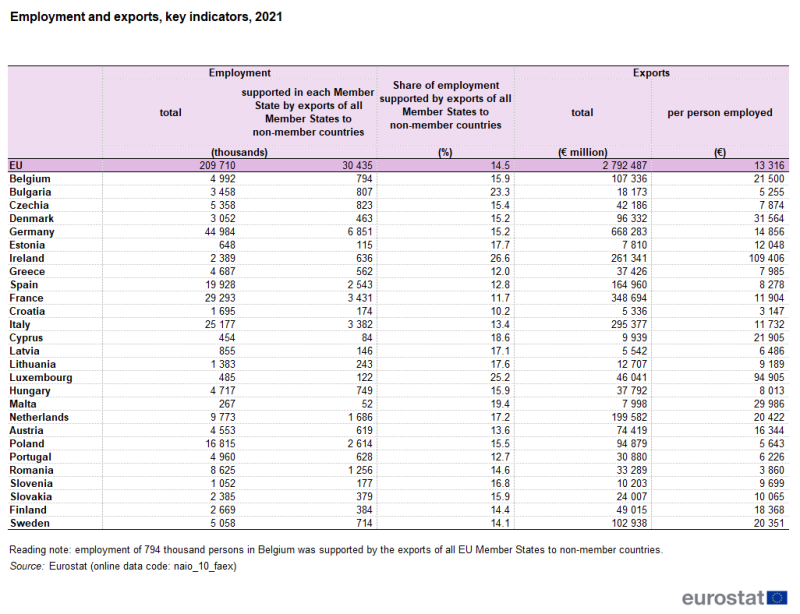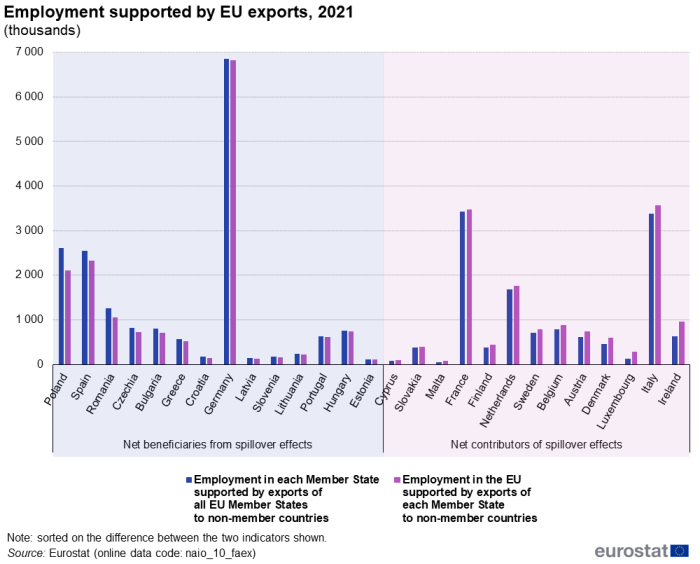Employment content in EU exports - an analysis with FIGARO data
Data extracted in November 2023.
Planned article update: 16 July 2024.
Highlights
In 2021, the employment of 30 million persons in the EU was supported by exports to non-member countries, equivalent to just over one in seven of the 210 million persons employed in the EU.
In 2021, the EU Member States with the highest share of employment supported by EU exports were Ireland (27 %), Luxembourg (25 %) and Bulgaria (23 %).
Germany was by far the largest contributor to export-supported employment spillover in the EU: in 2021, 1.1 million persons employed in EU Member States other than Germany were supported by German exports.
Manufacturing exports supported 17 million persons employed in the EU in 2021, 56 % of all export-supported employment.
Share of employment in each EU Member State supported by EU exports, 2021
The production of goods and services requires inputs which may have been sourced domestically or globally. The final value of a product may well reflect value that has been added in many different stages through the combination of factors of production, including employment. The employment input may have been located in many different countries.
An analysis of the employment content of exports of goods and services can provide insight into international trade relations. This article aims to provide an indication of the relationship between employment in the European Union (EU) and the EU's exports. This is done by analysing the employment content of EU exports at a detailed industry [1] level.
The article provides an overview of the data compiled using the FIGARO tables – full international and global accounts for research in input-output analysis – and the Leontief input-output model (Miller and Blair, 2009). For more information, see the Data Sources and Context sections below.
Full article
Whole economy – all industries combined
Number and share of persons employed
The number of persons employed in the EU or in individual EU Member States supported by exports includes not only employment in enterprises that are directly exporting, but also in those providing goods and/or services to support the production of exported goods and services; in other words, it also includes employment in upstream enterprises. This may concern employment in enterprises in the same industry as the exporter or in a different one (depending, in part, how detailed an activity classification is used). Equally, exports by enterprises in one Member State may support employment in that Member State or in a different one.
Regardless of whether presenting data for the EU as a whole or for individual EU Member States, all references to exports in this article concern exports to non-member countries, in other words extra-EU exports; trade between Member States is not considered.
Overall, the employment of 30 million persons in the EU in 2021 was supported by exports to non-member countries (Table 1). This export-supported employment accounted for 15 % of total employment (210 million persons), equivalent to just over one in seven persons employed within the EU.
Germany was the EU Member State with the highest employment supported by EU exports (see Table 1 and Figure 1): in 2021, the employment of 6.9 million persons in Germany was supported by exports from the EU, including from Germany itself. The level of export-supported employment in Germany was slightly more than the combined level of export-supported employment in France and Italy (both 3.4 million persons), which had the following highest levels (see Table 1). As a share of total employment, the employment in each of the Member States supported by exports to non-member countries ranged from just over 1 in 10 in Croatia (10.2 %) to approximately one in four in Bulgaria (23.3 %), Luxembourg (25.2 %) and Ireland (26.6 %).
In addition to estimating export-supported employment in each EU Member State, FIGARO also provides insight into the employment anywhere in the EU that is supported by the exports from a particular EU Member State. Figure 1 compares these two indicators. The figure has been ranked on the difference between the two indicators.
The EU Member States on the left-hand side of Figure 1 are those that benefited more (in employment terms) from exports from all Member States than the employment they supported in the whole EU through their own exports: in other words, they were net beneficiaries from cross-border spillover effects (see Box 1). For example, employment of 2.6 million persons in Poland was supported by exports from all Member States (including from Poland), whereas employment of 2.1 million persons across the EU (some of which in Poland) was supported by exports only from Poland; the difference – with Poland being a net beneficiary – was 510 000 persons employed. Similarly, all three Baltic EU Member States were net beneficiaries from spillover effects, as were most of the other eastern Member States (Bulgaria, Czechia, Croatia, Hungary, Romania and Slovenia), some southern Member States (Greece, Spain and Portugal) and Germany.
Conversely, the EU Member States on the right-hand side of Figure 1 are those that benefited less (in employment terms) from exports of all Member States than the employment they supported in the whole EU through their own exports: these Member States were therefore net contributors of cross-border spillover effects. As an example, in Ireland employment of 636 000 persons was supported by exports from EU Member States (including from Ireland), whereas employment of 955 000 persons across the EU (some of which were in Ireland) was supported by exports from Ireland alone; the difference was 319 000 persons employed, making Ireland the largest net contributor. Another large net contributor of spillover effects was Italy with a difference of 195 000 persons (Figure 1).
Figure 2 focuses on the change in export-supported employment within each EU Member State (supported by exports from anywhere in the EU). Nearly all EU Member States recorded an increase in export-supported employment between 2011 (during the recovery from the global financial and economic crisis) and 2021 (the second year of the COVID-19 pandemic). Small decreases in absolute and relative terms were observed in Sweden and Croatia.
The share of export-supported employment in total employment in the EU increased from 12.8 % in 2011 to 14.5 % in 2021. Overall, export-supported employment in the EU increased by 5.3 million during this period. About one sixth of the increase (851 000 more persons employed; 16.1 % of the EU increase) was located in Germany, with the next largest increases in Italy (715 000 more persons employed; 13.6 % of the EU increase), Poland (606 000 more persons employed; 11.5 % of the EU increase), and France (568 000 more persons employed; 10.8 % of the EU increase).
In relative terms, the largest increases in export-supported employment between 2011 and 2021 occurred in Cyprus (up 60.1 %), Greece (up 49.0 %), Ireland (up 43.9 %), and Malta (up 41.6 %).
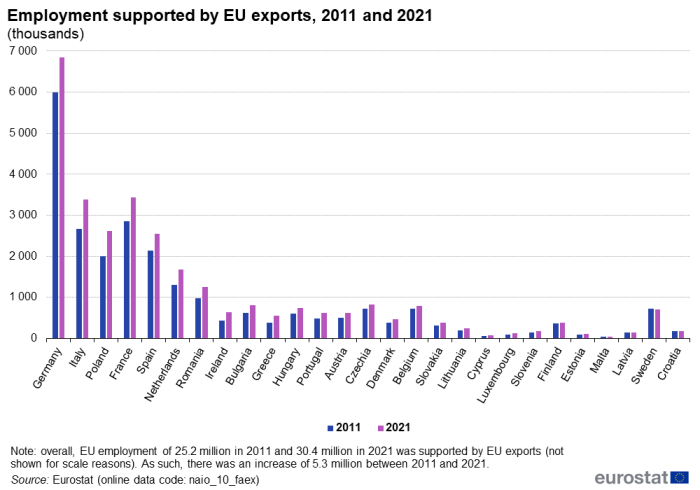
(thousands)
Source: Eurostat (naio_10_faex)
Domestic and spillover effects
The share of export-supported employment within each EU Member State can be divided into two parts – the domestic effect and the spillover effect – with a further division of the domestic effect between direct and indirect effects: see Box 1 for more information. The share of total employment in each Member State related to these effects is presented in Figure 3.
Box 1: What are domestic and spillover effects?
The domestic effect is employment in a given EU Member State that is supported by its own exports. This employment may be in the same industry as the one that exports the goods or services (direct domestic effect) or in another industry (indirect domestic effect). As such, the indirect domestic effect is effectively an industry spillover effect within a single EU Member State – it is the employment in a particular industry that is supported by the exports of a different industry (within the same Member State).
In this article, the split of the domestic effect into a direct and indirect effect is based on an analysis of the economy dividing it into 21 different industries (according to EU's activity classification called NACE).
The spillover effect reflects the employment in a given EU Member State that is supported by the exports of other Member States. For example, it includes employment in a Member State engaged in the production of intermediate inputs to be used in other Member States' exports to non-member countries.
In 2021, the direct domestic effect accounted for 6.8 % of total employment in the EU, while the indirect domestic effect accounted for 4.9 % and the spillover effect for 2.8 % (see Figure 3).
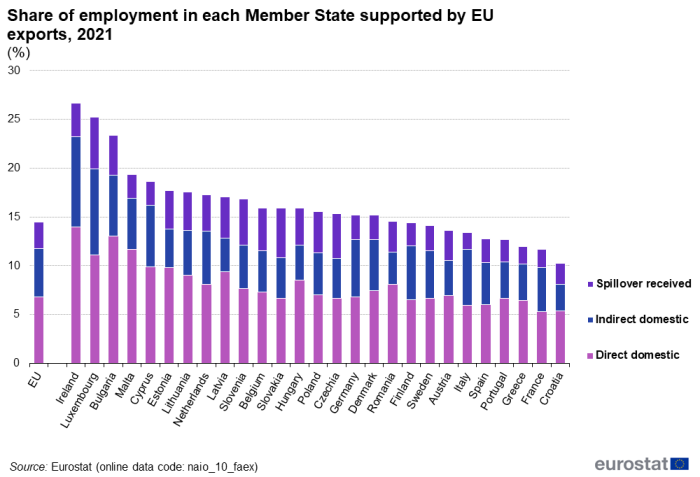
(%)
Source: Eurostat (naio_10_faex)
Among the EU Member States, the largest contributions to total employment of the direct domestic effect occurred in Ireland (13.9 %) and Bulgaria (13.1 %), while this effect also contributed 10.0 % or more of employment in Malta and Luxembourg. The lowest contribution of the direct domestic effect was observed in France (5.3 %). In turn, the largest contribution to total employment of the indirect domestic effect was in Ireland (9.3 %), followed by Luxembourg (8.8 %); the smallest contribution was in Croatia (2.7 %). Concerning spillover effects, the largest contribution to total employment was in Luxembourg (5.3 %), followed by Slovakia (5.0 %), Slovenia (4.7 %) and Czechia (4.6 %), while the smallest contributions occurred in France (1.9 %), Greece (1.8 %) and Italy (1.7 %) – see Map 1.
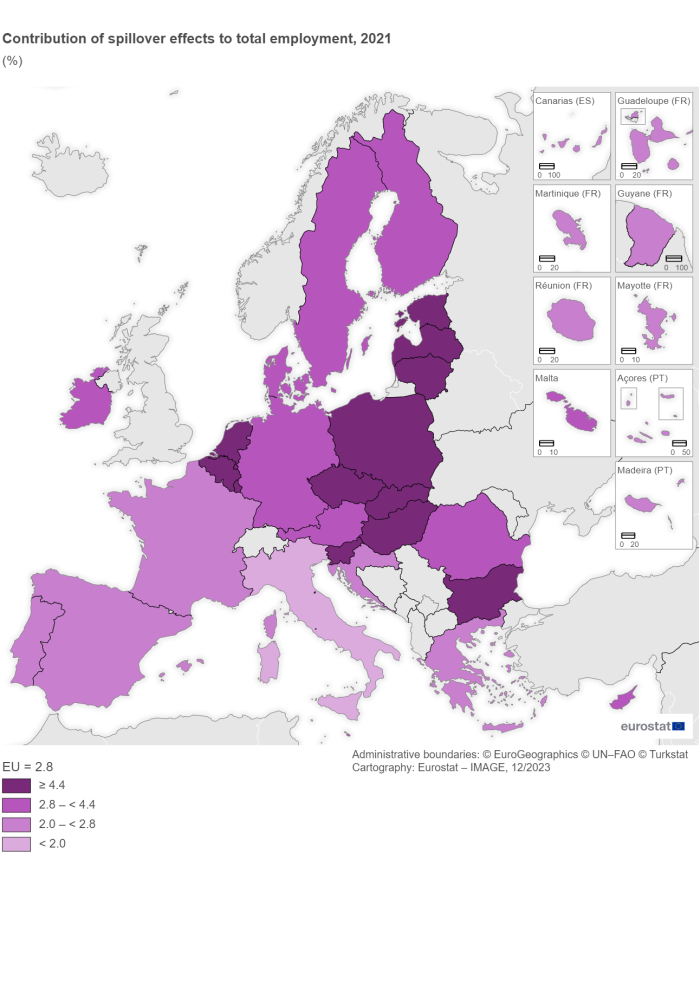
(%)
Source: Eurostat (naio_10_faex)
The direct domestic effect accounted for 47.1 % of all export-supported employment across the EU Member States in 2021. This effect was the dominant effect in all Member States (see Figure 3), accounting for more than half of export-supported employment in 13 of them. In relative terms, the largest impact of the direct domestic effect within all export-supported employment was 60.4 %, recorded for Malta; the smallest impact was 41.9 %, recorded for Slovakia.
The indirect domestic effect accounted for 33.8 % of all export-supported employment in the EU Member States in 2021. This was the second largest effect (among the three shown in Figure 3) in 20 of the Member States: in Slovakia, Latvia, Czechia, Slovenia, Hungary, Belgium and Estonia, the spillover effect was larger. The indirect domestic effect accounted for one fifth to two fifths of export-supported employment in all but one of the Member States: the lowest share was 20.2 % in Latvia while the highest share – over two fifths – was 42.7 % in Italy.
Finally, the spillover effect accounted for 19.1 % of all export-supported employment in the EU Member States in 2021. This effect accounted for 12.6 % of export-supported employment in Malta, while there were also relatively low shares in the three largest EU Member States: 13.0 % in Italy, 16.2 % in France and 16.7 % in Germany. The spillover effect accounted for one quarter or more of export-supported employment in five Member States, peaking at 31.7 % in Slovakia.
Export-supported employment from the domestic and spillover effects are shown in absolute values for 2021 in Table 2. Employment from the domestic effect is shown in the shaded cells running in a diagonal line from the top left to the bottom right of the table.
In 2021, the largest level of export-supported employment resulting from the domestic effect was clearly in Germany, where 5.7 million persons employed were supported by Germany's own exports, with the next largest domestic effects observed in Italy and France (both 2.9 million).
The single largest spillover effect between any pair of countries in 2021 was the 211 000 persons employed in Poland and supported by German exports. Five other country pairings had spillover effects of more than 100 000 persons employed:
- 153 000, 137 000 and 119 000 persons employed in Germany who were supported by French, Italian and Dutch exports, respectively;
- 124 000 persons employed in France who were supported by German exports;
- 107 000 persons employed in Italy who were supported by German exports.
Germany was by far the largest contributor of export-supported employment resulting from spillover effects: 1.1 million persons employed in 2021 in EU Member States other than Germany were supported by German exports. Out of this figure, 211 000 were in Poland, 124 000 in France and 107 000 in Italy, while Spain (91 000), Czechia (86 000), the Netherlands (78 000), Austria (59 000), Romania (54 000) and Hungary (52 000) all had more than 50 000 persons employed who were supported by German exports. For comparison, the next highest contributors to employment spillover were Italy (633 000 persons employed in other Member States), France (595 000), the Netherlands (443 000) and Ireland (401 000).
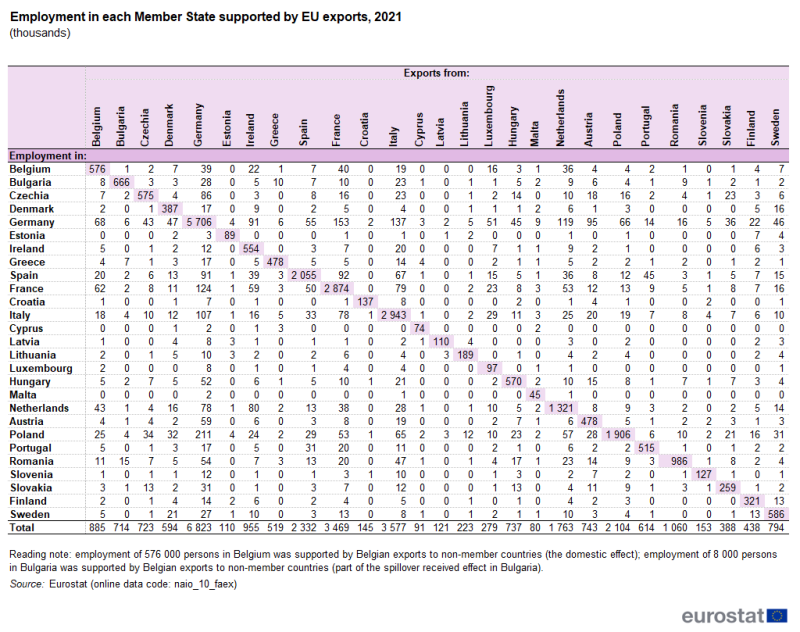
(thousands)
Source: Eurostat (naio_10_faex)
Industries
Whereas Table 2 focused on employment in EU Member States supported by exports, Table 3 provides a similar analysis for industries. This presentation reveals the extent to which employment in specific industries is dependent on exports from the same industry or from other (downstream) industries. Unlike Table 2, Table 3 does not show absolute values of the number of persons employed but instead presents employment shares. The shares in each column sum to 100 %: each column shows the distribution (among employing industries) of employment that is supported by exports from a specific industry.
The share of export-supported employment within the same industry as the exporting industry is shown in the shaded cells running in a diagonal line from the top left to the bottom right of the table. The largest share [2] was observed for education: in 2021, 89.9 % of all employment in the EU supported by exports from this industry occurred in the education industry itself. The 20 other industries received the remaining 10.1 %, with the administrative and support service activities industry as the largest beneficiary (2.6 %) of export-supported employment from industrial spillover effects.
By contrast, three industries had shares along this diagonal that were below 50 % in 2021.
- For employment supported by exports from the mining and quarrying industry, 45.0 % was in the same industry, 9.9 % was in administrative and support service activities, 8.7 % in manufacturing, 8.6 % in distributive trades and 8.2 % in transportation and storage.
- For employment supported by exports from the electricity, gas, steam and air conditioning supply industry, 31.3 % was in the same industry, 10.0 % in administrative and support service activities, 9.7 % in manufacturing and 9.5 % was in distributive trades.
- For employment supported by exports from real estate activities, 31.2 % was in the same industry, 16.4 % was in construction, 8.1 % in professional, scientific and technical activities (which includes, among others, the activities of notaries, architectural and engineering services), 7.7 % in manufacturing, 7.6 % in administrative and support service activities, and 6.0 % in financial and insurance activities.
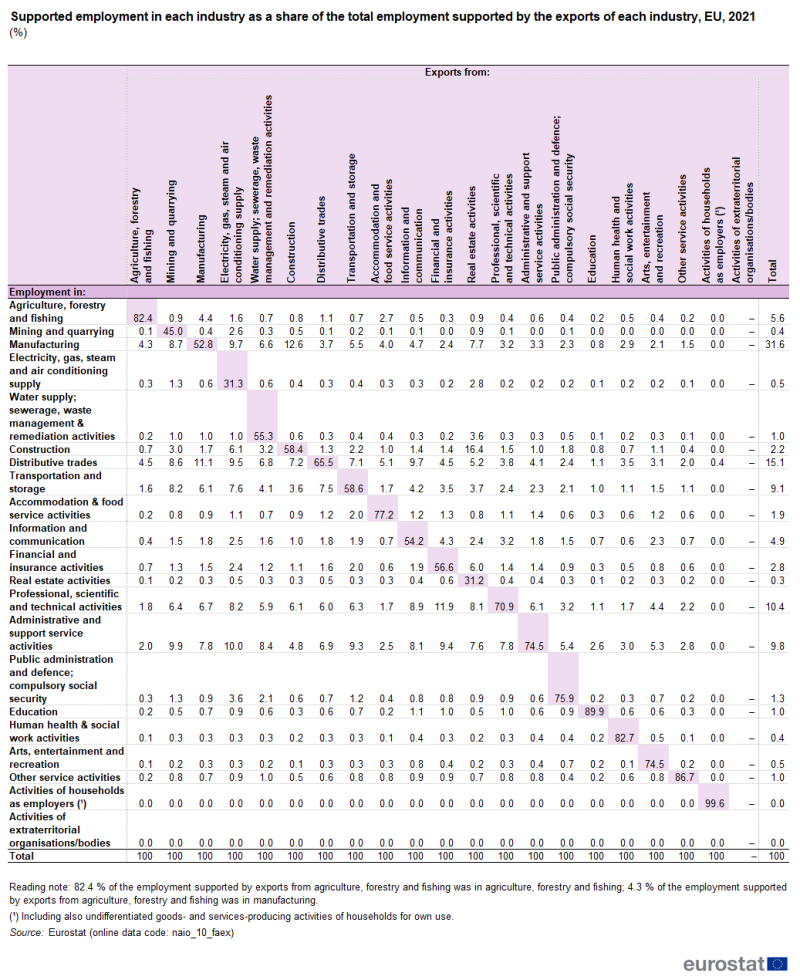
(%)
Source: Eurostat (naio_10_faex)
In 2021, the single largest industrial spillover effect between any pair of industries was the 16.4 % noted above for employment in construction supported by exports from real estate activities. Four other industry pairings had industrial spillover effects exceeding 10.0 % of the employment supported by exports from a particular industry:
- 12.6 % of the employment supported by construction exports was in manufacturing;
- 11.9 % of the employment supported by exports of the financial and insurance activities industry was in the professional, scientific and technical activities industry;
- 11.1 % of the employment supported by manufacturing exports was in distributive trades;
- 10.0 % of the employment supported by exports from electricity, gas, steam and air conditioning supply was in administrative and support service activities.
In absolute terms, the picture is somewhat different, as manufacturing exports alone supported 17.2 million persons employed in the EU in 2021, equivalent to more than half (56.4 %) of all export-supported employment in the EU. Some 9.1 million of this total were employed within manufacturing itself, with the remaining 8.1 million persons representing the industrial spillover effect within the other 20 industries. The eight largest industry pairings for export-supported employment resulting from industrial spillover effects all concerned employment in industries outside the manufacturing industry itself that were supported by manufacturing exports. For example, 1.9 million persons employed in distributive trades were supported by manufacturing exports, as were 1.3 million persons in administrative and support service activities, 1.1 million persons in professional, scientific and technical activities, and a further 1.1 million persons in transportation and storage (see Figure 4).
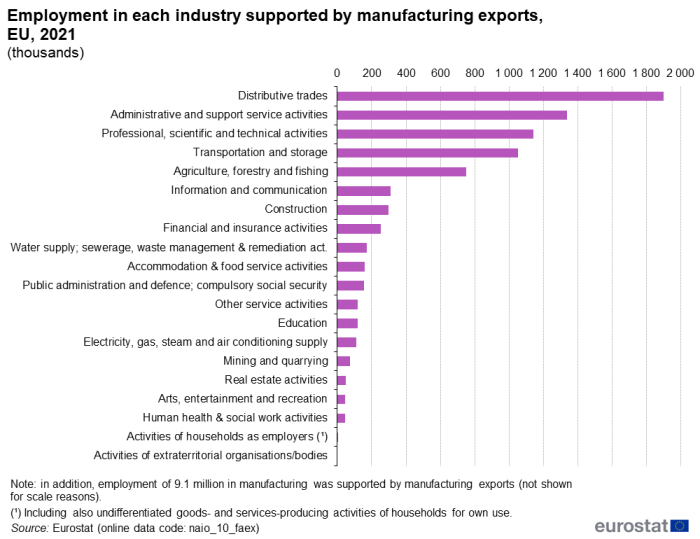
(thousands)
Source: Eurostat (naio_10_faex)
In 2021, the largest pairing of industrial spillover effects that did not involve manufacturing was the 242 000 persons employed in transportation and storage activities supported by exports from distributive trades.
Table 4 identifies, for each EU Member State, which two industries had the highest level of export-supported employment. In 22 Member States, manufacturing had the highest level of export-supported employment in 2021, while there were two Member States where manufacturing had the second highest level. Cyprus, Luxembourg and the Netherlands were exceptions as manufacturing was not one of the two industries with the highest levels of export-supported employment. The next most common industry in Table 4 was distributive trades, which had the highest level of export-supported employment in one Member State (namely, Greece) and the second highest in 12 more.
Six other industries appear in Table 4:
- administrative and support service activities – five times (Belgium, Cyprus, Luxembourg, Hungary and Sweden);
- professional, scientific and technical activities – three times (France, the Netherlands and Portugal);
- transportation and storage – three times (Estonia, Greece and Lithuania);
- financial and insurance activities – three times (Cyprus, Luxembourg and Malta);
- agriculture, forestry and fishing – twice (Bulgaria and Romania);
- information and communication – once (Finland).
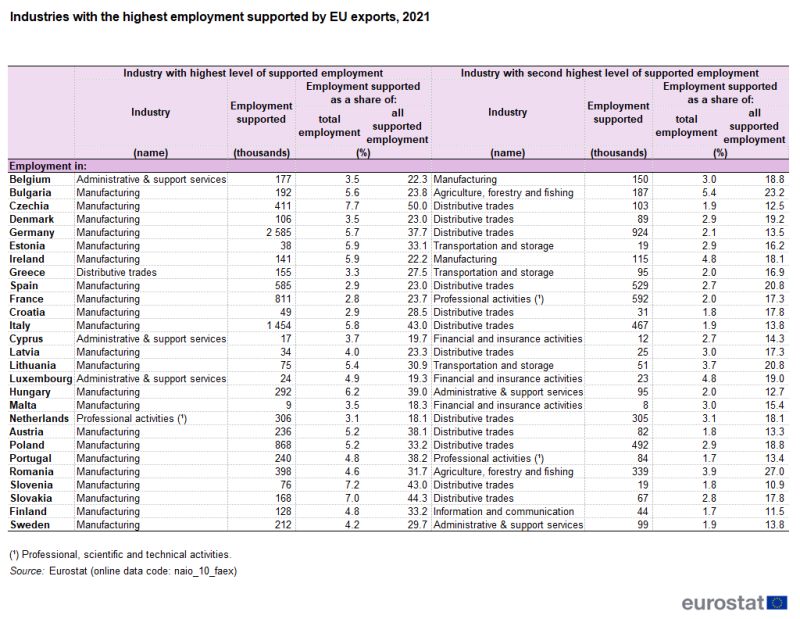
Source: Eurostat (naio_10_faex)
Earlier it was noted that a considerable number of persons employed in other industries are supported by exports from the manufacturing industry. Nevertheless, in most EU Member States – including the five largest ones – manufacturing had the highest absolute level of employment supported by exports (from any industry).
Source data for tables and graphs
![]() Employment content in EU exports: tables and figures
Employment content in EU exports: tables and figures
All FIGARO data for employment are available from the following files:
They can also be accessed through the Eurostat dissemination database: (naio_10_faex)
Data sources
Concept
The FIGARO tables are a statistical product of the integrated global accounts for economic modelling. They link national accounts and data on business, trade and jobs for the EU Member States and 18 main EU trading partners of the EU (Argentina, Australia, Brazil, Canada, China, India, Indonesia, Japan, Mexico, Norway, Russia, Saudi Arabia, South Africa, South Korea, Switzerland, Türkiye, the United Kingdom and the United States). A 'rest of the world' region completes the FIGARO tables.
The FIGARO tables present the relationship between economies at a detailed level of 64 industries and 64 products, as defined in the ESA 2010 national accounts transmission programme.
The three following main applications are produced based on the FIGARO tables:
- employment supported by EU exports to the rest of the world,
- value added supported by EU exports to the rest of the world,
- CO2 emissions footprints linked to final consumption and investment in the EU.
Frequency and availability
The FIGARO tables are produced and updated annually, as are the results for the three main FIGARO applications. In 2023, the time series from 2010 to 2021 has been published (period t–24 months, t being the year of release). The time series is in line with the latest macroeconomic aggregates. This release is linked to major improvements both in terms of data availability and methodology, namely:
- the results are available in the Eurostat online database with a tool that offers the possibility to customise, visualise (for example, using a chart, bar chart and a map) and extract statistical data in an easy and interactive way;
- the FIGARO tables and applications benefit from several methodological improvements, such as enhanced adjustments linked to discrepancies between trade statistics and national accounts;
- the quality has also been further enhanced due to the inclusion of fresher data, leading to less data estimation, in particular for the EU's main trading partners.
More information
For more information, please refer to the dedicated section for the input-output and FIGARO tables.
Context
Partners
The FIGARO tables are the result of a long-term collaboration between Eurostat and the European Commission's Joint Research Centre. Both partners also collaborate in the OECD expert group on regional-global trade in value-added (TiVA) initiatives, which aims to explore synergies and common action among the various initiatives on extended supply, use, and input-output tables.
Purpose
The FIGARO tables provide the first official inter-country supply, use and input-output data for the EU. They are a tool for analysing the social, economic and environmental effects of globalisation. These may be analysed through studies on competitiveness, growth, productivity, employment, environmental footprint and international trade (for example, analyses of global value chains).
The tables are used to evaluate EU policies and assess the economic interdependencies of the EU (or the euro area or individual EU Member States) in a globalised world.
Notes
- ↑ The terms industry/industries are used as synonyms for the activity/activities listed in the NACE Rev. 2 classification.
- ↑ Leaving aside the small and somewhat atypical activities of households as employers and the undifferentiated goods- and services-producing activities of households for own use.
Direct access to
- Data can be accessed through the dedicated section as CSV files (flat or matrix format) and Excel files.
- Data are also available from the Eurostat dissemination database: (naio_10_faex)
